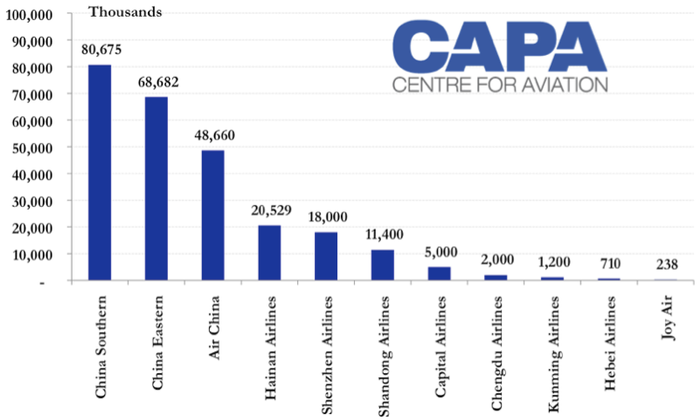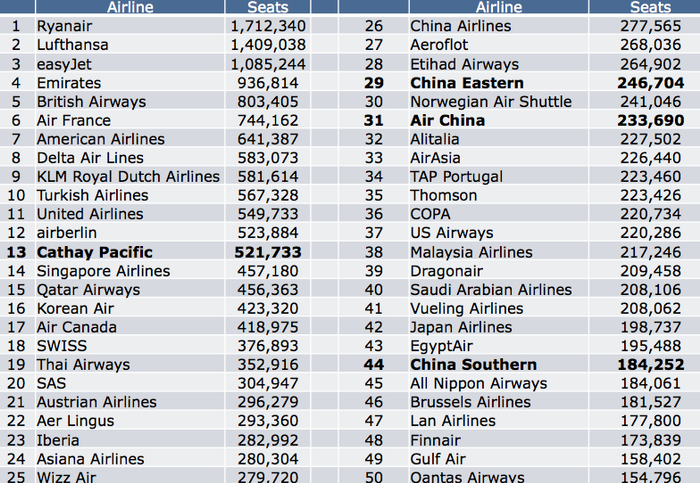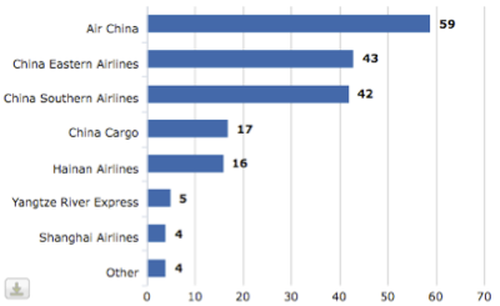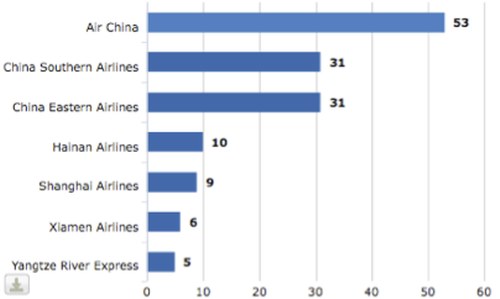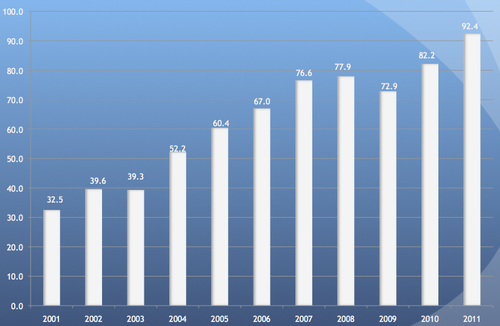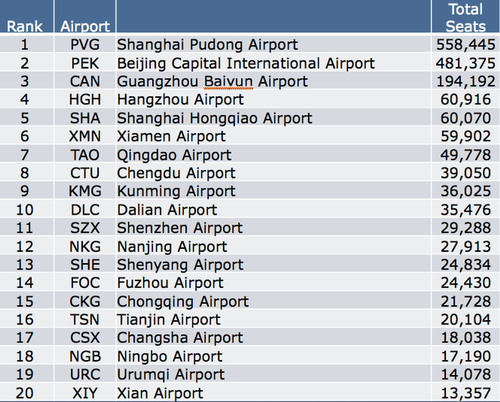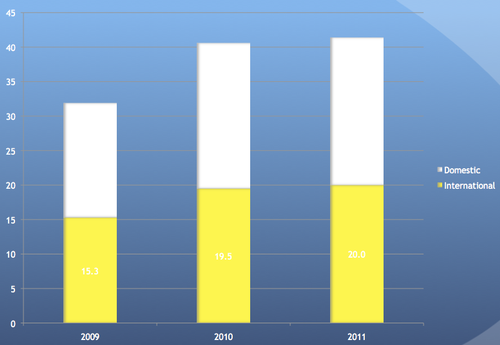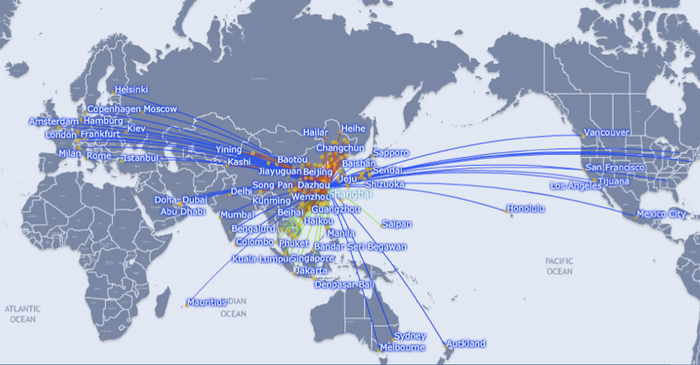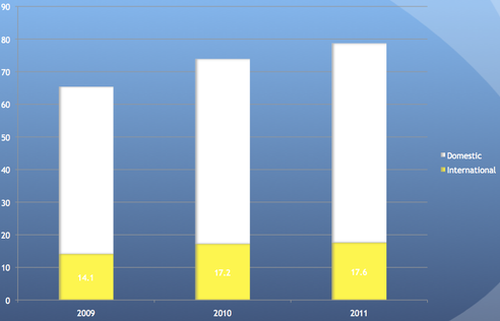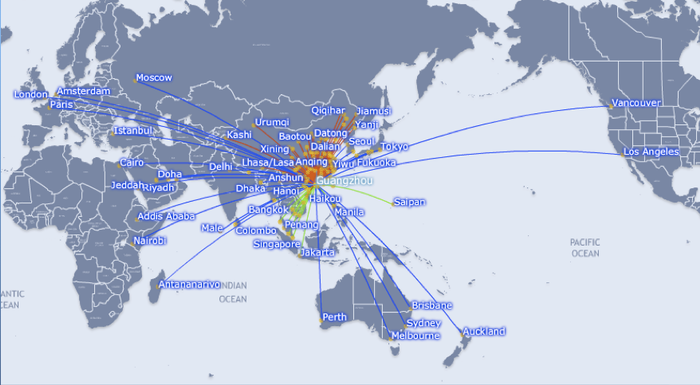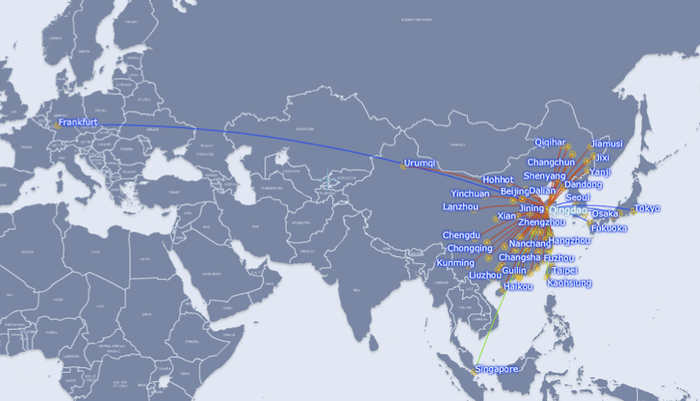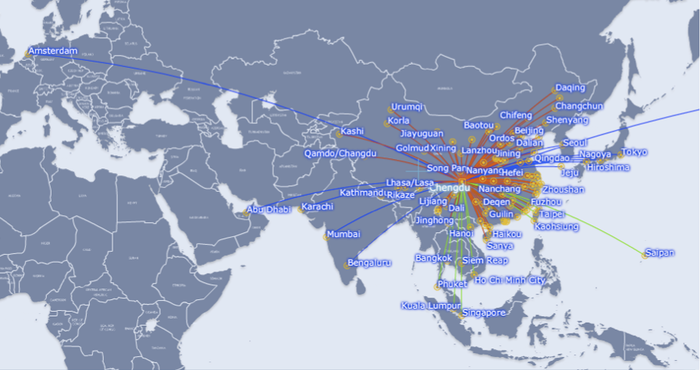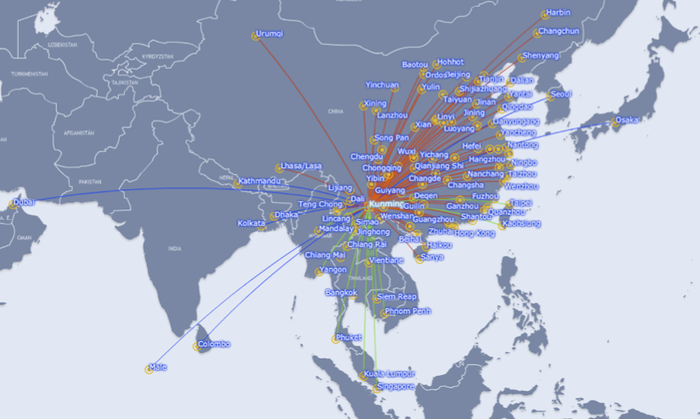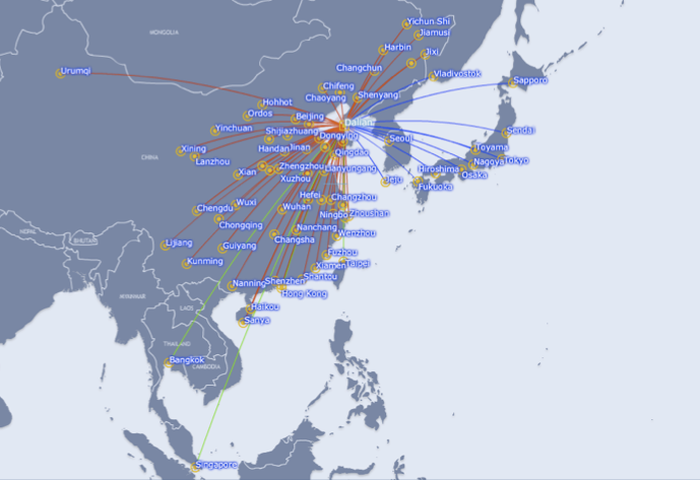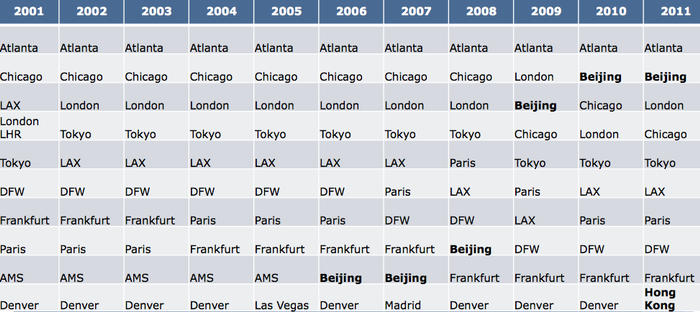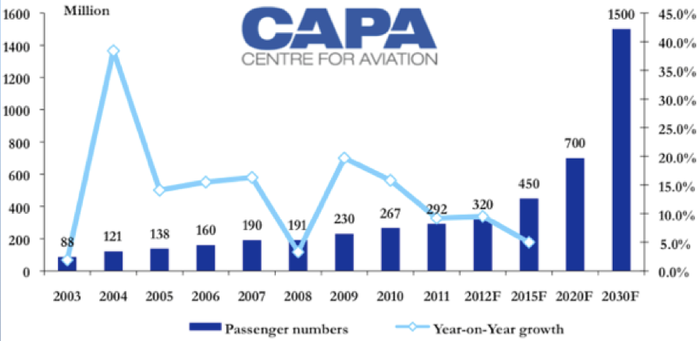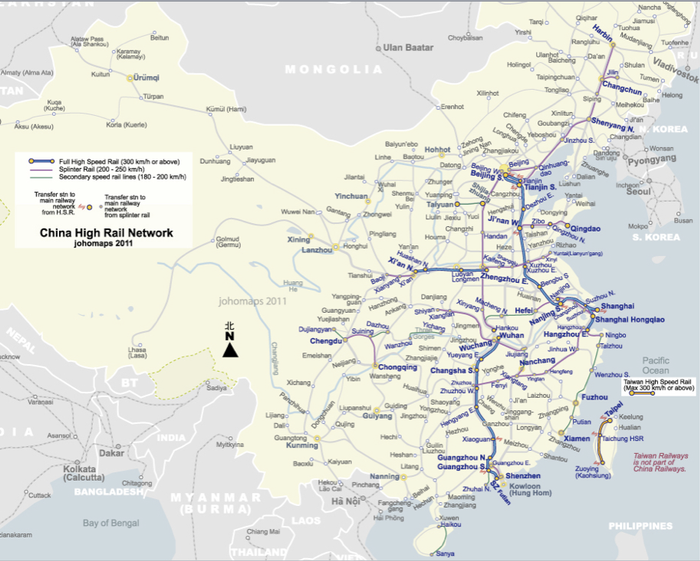New routes to China to flourish in the next few years
China's leading airports are on the cusp of strong international growth, with several new routes to be launched in the coming 12 to 24 months. Growth will be driven by foreign and local needs: countries will have greater needs to further link with China while locally there will be an increasing propensity to travel among the Chinese population as incomes rise, while high-speed rail expansion will push Chinese airlines to grow internationally, at the same time providing feed opportunities for foreign carriers at the main Chinese gateways.
But growth is not only expected at the main Chinese hubs. Second tier airports can also look forward to increasing air services as the Government supports expansion from these hubs and as the LCC revolution takes hold in North Asia. New carriers across the region will be looking for new route opportunities, fuelling rapid growth at non-congested Chinese gateways. China's own second tier airlines are also looking to expand abroad, mainly within the Asia Pacific region, which will spur development at the provincial capitals across China's vast interior and economic zones.
- China's leading airports are expected to experience strong international growth in the next 12 to 24 months, driven by both foreign and local needs.
- Second-tier airports in China will also see increasing air services as the government supports their expansion and the low-cost carrier revolution takes hold in North Asia.
- The Middle East carriers are aggressively expanding into China, providing extensive linkages to other parts of the world, particularly Africa and South America.
- China's domestic market currently accounts for four out of five seats produced in the market, with Chinese airlines focusing on domestic and short-haul international expansion.
- China ranks eighth globally in terms of international air capacity, but its international air travel market is growing strongly and is expected to exceed 100 million seats this year.
- Shanghai Pudong Airport, Beijing Capital Airport, Guangzhou Baiyun Airport, Hangzhou Airport, Shanghai Hongqiao Airport, and Xiamen Airport are among the top Chinese airports expected to see significant growth in the next few years.
The opening of secondary airports in China, such as Chongqing and Chengdu, is also of interest to foreign and local carriers, opening up new slot opportunities. Finnair commenced services to Chongqing in May-2012 while Air France in Apr-2012 opened a route to Wuhan. Both carriers already had services to China's main two entry points, Beijing and Shanghai, while many other international carriers only serve one or none, making them more likely to first enter Beijing or Shanghai before branching into smaller destinations.
China can offer numerous hubs: west (Urumqi) for Russia/CIS traffic, northeast (Beijing) to Japan and Korea, southwest (Chengdu/Chongqing) to the Indian Subcontinent and southeast (Guangzhou) to Asia and Australia.
Meanwhile, the Middle East carriers continue to expand aggressively into China, providing extensive linkages to other parts of the world. Notable emerging market linkages are to Africa, where China is significantly boosting trade and investment, as well as the high-growth economies of South America. African carriers are also expanding to China, while the European major carriers are expected to continue to cherry pick key Western Chinese cities with new routes from their hubs, especially as new generation aircraft enter their fleets.
China's airport sector recorded a very positive 2011, particularly among the second tier airports, where growth rates of 15%+ were commonplace. Guangzhou led the big three Chinese hubs in terms of growth rates, while Beijing edged closer to Atlanta as the world's busiest airport.
See related articles:
- Beijing narrows gap with Atlanta as world's busiest airport while Haneda overtakes Heathrow as #3
- Beijing briefly assumes title of world's largest airport as Spring Festival traffic soars
China's leading airports: 2011 pax (size of bubble) and growth

Chinese airlines strong in massive domestic market while small presence internationally has large affects
Of China's 'Big Three', China Southern Airlines eclipsed the 80 million passenger mark last year, while China Eastern and Air China neared 70 million and 50 million, respectively, due mainly to growth in the burgeoning domestic market.
Select Chinese carriers' passenger numbers (000s): 2011
The domestic market currently accounts for four in five seats produced in the markets.
China international vs domestic seats market proportion (%): 06-May-2012 to 12-May-2012
On total system seats, China Southern is the world's eighth largest carrier, China Eastern the ninth and Air China the 13th - surpassing carriers including British Airways, Emirates and Cathay Pacific. But excluding domestic seats and looking only at international seats, no Chinese carrier is in the top 10. Just one mainland carrier - China Eastern - is in the top 30.
Top 50 airlines by seats per week: 06-May-2012 to 12-May-2012
There are 190 widebody aircraft in service in the entire Chinese mainland fleet. By comparison, Cathay Pacific and Dragonair have almost 150 widebodies in services between them. And the outlook for widebody fleet growth in China is also instructive, with just 145 widebodies on order at present compared to Emirates' 230 on order.
But China's carriers are increasingly having a disproportionate effect on competition as their low cost bases offer lower fares, bringing in concentrated form to Asia Pacific what Middle East network carriers have achieved - to the chagrin of others - globally.
See related article: Chinese airlines' sixth freedom roles could challenge Middle East, Asian, European hubs this decade
Chinese carriers will continue to focus on domestic and short-haul international expansion with this fleet profile, although China Eastern and China Southern intend to take delivery of 777-300ERs. This domestic focus is partially driven by the state, recognising the international - and especially long-haul - market is subject to significant volatility whereas domestic is strong. Domestic flights also arguably achieve more for China's economic growth than do international services.
Mainland China's widebody fleet in service and on firm order: May-2012
| In service |
|---|
|
|
| On order |
|
|
China ranks eighth globally in terms of international air capacity (annual seats). This is a surprisingly low ranking for the second ranked global economy. When including domestic seats, China is the second largest by far but still half the size of market leader the US.
Top 10 international aviation markets (seats): 2011 and growth
But greater China's international air travel market is growing strongly and is expected to comfortably exceed 100 million seats this year.
International capacity seats (mill) to/from China (seats): 2001 to 2011
China's top international airports: varying prospects
Growth will be felt across the Chinese airport network, but some airports are positioned to gain a disproportionate share. Due to their geographic position and/or unique characteristics, such as access to tourism resources, these airports will gain some new air services.
The table below lists the Chinese mainland's top 20 international gateways by seats per week. Some explosive growth could be witnessed in the bottom half of the table, however. In the following section, we specifically review the top 10 gateways' prospects for new air services over the next 12-24 months.
China's top 20 international airports, ranked by seats per week: 30-Apr-2012 to 06-May-2012
#1 Shanghai Pudong Airport
Shanghai Pudong Airport is China's leading international gateway with some 550,000 international seats per week. The international market now accounts for just under half of Pudong's traffic.
Shanghai Pudong International Airport annual passengers, domestic vs international (mill): 2009 to 2011
|
The outlook for Shanghai Pudong is for more gateways and frequencies in Asia, as well as expansion to the growth markets of the Middle East and Africa. Slower growth is expected to Europe and North America with more frequencies expected on established routes. It is possible some 'wild-card' new destinations will be added in both markets as Chinese second tier carriers take advantage of route rights spurned by the 'Big Three' local carriers. The biggest restrictions on Pudong's growth include a lack of favourable slot timings, congestion and government restrictions on newer entrants. |
|
Shanghai Pudong Airport route map: 06-May-2012
#2 Beijing Capital Airport
Beijing Capital Airport has a similar outlook, but divergent current positioning. Beijing is predominantly a domestic gateway with less than a quarter of the airport's passengers boarding international services last year. That proportion is expected to diminish further as the domestic air market continues to blossom in the capital.
Beijing Capital Airport annual passengers, domestic vs international (mill): 2009 to 2011
|
Beijing has some 110 domestic destinations, but has fewer Asia Pacific gateways than Shanghai Pudong (34 vs 44). But Beijing enjoys a much stronger position in European markets (28 cities vs 10) and is slightly stronger in the Middle East and North America. The outlook for Beijing Capital is broadly similar to Pudong's, namely slower growth to Europe/North America as economic conditions soften, but stronger growth to Asia and other emerging markets. A major constraint at Beijing, however, is its congestion and a lack of slots makes it effectively off limits to any would-be new entrants, except those prepared to offer arrivals and departures in the middle of the night. |
Beijing Capital Airport route map: 06-May-2012
#3 Guangzhou Baiyun Airport
| Guangzhou Baiyun, with its extensive domestic linkages, is expected to branch out over the next couple of years with greater connectivity between Australia/Asia and existing European ports as China Southern develops a sixth freedom 'Canton Route' capability. China Southern is aggressively building an international network as high-speed rail threatens its network in particular.
The biggest growth for Guangzhou is expected to be from the Asia Pacific region with healthy increases in frequencies and new destinations. China Southern will account for a significant proportion of growth. No North American carriers serve Guangzhou, although Delta and United serve nearby Hong Kong. Delta recently postponed to Jun-2013 tentative Tokyo-Guangzhou service, having already delayed it from 2011. Guangzhou experiences extreme congestion in Pearl River Delta air space and limits on attractively timed slots. |
Guangzhou Baiyun Airport route map: 06-May-2012
#4 Hangzhou Airport
|
Hangzhou, near Shanghai in the Yangtze River Delta, is a destination in its own right, unlike Tianjin which fulfills mainly a 'Beijing alternative' role. CAPA is bullish on Hangzhou's growth trajectory. In the medium term, we see it becoming a Chinese and Asian destination, while a Gulf link is also a possibility within 12 months. A US or Chinese carrier may look at a trans-Pacific route to Hangzhou in the next 24 months and a 'wild-card' new route to Europe is also possible. More likely, however, is frequency increases to existing ports. Asia Pacific will again fuel this airport's growth with likely increases in frequencies and new destinations driven by the region's new LCCs. |
Hangzhou Airport route map: 06-May-2012
#5 Shanghai Hongqiao AirportShanghai Hongqiao Airport is an international short-haul growth story, fuelled by regulatory changes involving South Korea and Japan to allow services from their downtown airports by flag carriers. There may be increases in frequencies and new destinations driven by the full service airlines, but LCCs are likely to continued to be denied entry. |
Shanghai Hongqiao Airport route map: 06-May-2012
#6 Xiamen AirportXiamen Airport, the sixth ranked international gateway in China, is likely to see good increases in frequencies and destinations within Asia, driven by LCC expansion. It is possible a new Gulf link could be established before any more destinations are added in Europe. |
Xiamen Airport route map: 06-May-2012
#7 Qingdao AirportAnother eastern seaboard powerhouse, Qingdao, is also likely to see strong growth in frequencies and destinations in Asia driven by the LCCs and expanding second tier airlines in the region. A Middle East service is also a possibility, given Qingdao's industrial links with the region, Africa and beyond. |
Qingdao Airport route map: 06-May-2012
#8 Chengdu AirportChengdu, in China's burgeoning southwest, has a strong domestic and expanding Southeast Asian network. More frequencies and destinations, driven by LCCs and second tier carriers, are expected in Asia in the near term, as is a link to Australia in next 12-24 months. Services to the Gulf region are likely prior to the addition of more destinations in Europe, in CAPA's view. |
Chengdu Airport route map: 06-May-2012
#9 Kunming AirportKunming will benefit from a new airport, which will open up much needed capacity and slots at the southwest hub. The city is well positioned for services to the Indian Subcontinent, as good increases in frequencies and destinations are expected across Asia in the coming 12 months. Another one or two long-haul links to the Middle East and/or Europe are expected as the region's cultural heritage and scenery attract increasing numbers of tourists. |
Kunming Airport route map: 06-May-2012
#10 Dalian AirportDalian, an industrial hub in China's northeast, has developed a strong franchise of routes into neighbouring Korea and Japan. Protected from most of the effects of high-speed rail development, Dalian's international expansion is likely to be focussed on short-haul hops to North Asian cities, though a new linkage to Europe is not out of the question, given its strong industrial linkages. |
Dalian Airport route map: 06-May-2012
Appendix
Beijing is expected to overtake Atlanta as world's busiest airport later this year.
Ranking of the top 10 airports worldwide
China's increasing propensity for travel is well documented. As incomes rise, China will move up the curve as many before it have done, such as Japan and South Korea.
Propensity for airline travel vs GDP per capita
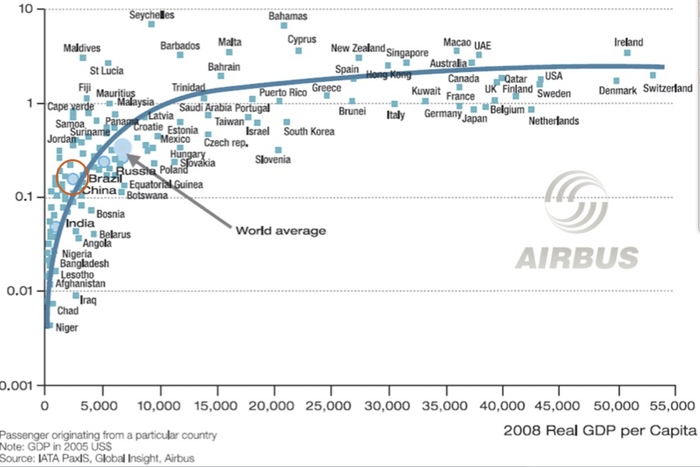
Rising incomes directly feed into CAAC's own forecasts for growth in demand for air travel in China, which is expected to swell to 450 million airport passengers by 2015 and 700 million by 2020.
CAAC passenger numbers and growth forecast: 2003 to 2030F
The bullish air travel forecasts have been set despite the impact of the expansion of the high-speed rail network in China, which CAPA expects will drive an increasing focus by Chinese airlines on expanding into international markets.
High-speed rail map: 2012
